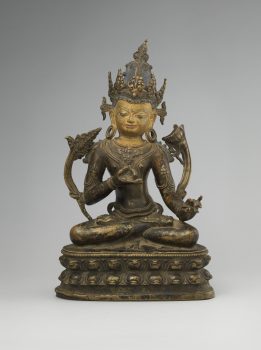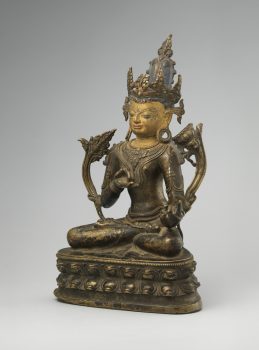Central Tibet
13th century
Also known as vajra position, this posture is associated with meditation.
Central Tibet
13th century




At first glance this sculpture appears to represent the bodhisattva Avalokiteshvara, who has a lotus as his symbol. However, closer inspection reveals that the figure once held a vajra upright between two fingers of his right hand. A break on the lotus further indicates that there was once a bell attached to it. These subtle details reveal that this is in fact Vajrasattva, who is considered a primordial buddha, a meditation deity, and the primary bodhisattva of the vajra family.In works of early central-Tibetan art such as this, figures have massive heads and disproportionally large hands and feet. Metal sculptures are made of a rather dark copper alloy, and the figures are depicted in elegant poses with a minimal sense of movement. The deities have high hair knots at the back of their heads, crowns with large points set apart from each other, ribbons and circular earrings, and strands of hair falling on their shoulders. They sit on double-lotus thrones with plain, fleshy petals. The large jewelry they wear is graceful but has little variation.
A religious movement that originated in India around the fifth to seventh century with sacred writings and esoteric teachings and practices transmitted from teacher to student through initiation. These remain an important part of Hinduism and Buddhism today.
In Buddhism merit is accumulated through engaging in positive actions that lead to positive results, such as better rebirths. Buddhists gain merit by making offerings, donating to those in need, reciting mantras, and other good deeds.
Prescribed practices that carry symbolic meaning and value within a specific tradition and are intended to attain a desired outcome. Rituals are usually done as part of a ceremony or regular routine.
Beings who aspire to become fully awakened like the Buddha and are dedicated to helping others on the path to enlightenment.
Today, Tibetans primarily inhabit the Tibetan Plateau, situated between the Himalayan mountain range and the Indian subcontinent to the west, Chinese cultural regions to the east, and Mongolian cultural regions to the northeast. During the 7th to 9th century, Tibetan rulers expanded their empire across Central Asia, and established Buddhism as the state religion.
Get the latest news and stories from the Rubin, plus occasional information on how to support our work.